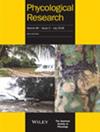Morphological and molecular characterization of multiple new Azadinium strains revealed a high diversity of non‐toxigenic species of Amphidomataceae (Dinophyceae) including two new Azadinium species in Irish waters, North East Atlantic
IF 1
4区 生物学
Q2 MARINE & FRESHWATER BIOLOGY
引用次数: 9
Abstract
Shellfish contamination with azaspiracids (AZA), which are lipophilic marine biotoxins produced by marine dinoflagellates, is a major and recurrent problem for the Irish shellfish industry. AZA are produced by certain species of Amphidomataceae, but the species diversity of this group of microalgae in Irish waters is poorly known. Here we present a morphological and molecular characterization of multiple new strains of non‐toxigenic Azadinium isolated on an oceanographic survey in 2018. A lack of AZA production for all strains presented here was demonstrated by LC‐MS/MS analysis. One strain of Azadinium caudatum var. margalefii (first strain for the area) confirmed non‐toxigenicity of Atlantic populations of this species. One strain designated as Azadinium cf. zhuanum was similar to Az. zhuanum described from China but differed from the type strain in nucleus position, by the dominant number of apical plates, and by significant differences in rRNA gene sequences. Finally, two new non‐toxigenic Azadinium species are described from the North East Atlantic: Azadinium galwayense sp. nov. and Azadinium perfusorium sp. nov. Azadinium galwayense differed from other Azadinium by a characteristic combination regarding presence and location of the ventral pore (vp; on the right side of the pore plate), of a pyrenoid (located in the episome), and by a pentagonal shape of the median anterior intercalary plate 2a, and lack of contact between plates 1″ and 1a. Azadinium perfusorium shared the same vp position as Az. galwayense and differed by a characteristic combination of a pyrenoid located in the hyposome, a tetragonal shape of plate 2a, and a relatively large size of the two lateral anterior intercalary plates. Molecular phylogeny confirmed the distinctiveness of these two new species and their placement in Azadinium. The present findings significantly increased knowledge on the diversity of Azadinium species in the North East Atlantic.对东北大西洋爱尔兰海域多个氮鎓新品系的形态和分子特征分析表明,该品系属两栖科(Dinophyceae)非产毒物种具有高度的多样性,其中包括两个氮鎓新品系
氮藻酸(AZA)污染贝类是由海洋鞭毛藻产生的亲脂性海洋生物毒素,是爱尔兰贝类行业的一个主要和经常性问题。AZA是由某些种类的amphiidomataceae产生的,但这类微藻在爱尔兰水域的物种多样性知之甚少。在这里,我们介绍了2018年海洋调查中分离到的多种非产毒Azadinium新菌株的形态和分子特征。LC - MS/MS分析表明,所有菌株都缺乏AZA的产生。一株尾尾叠氮(Azadinium caudatum var. margalefii)(该地区的第一株)证实该物种在大西洋种群中具有非毒性。其中一株被命名为Azadinium cf. zhuanum的菌株与中国的Azadinium . zhuanum相似,但在细胞核位置、顶端板的优势数量以及rRNA基因序列上与型菌株存在显著差异。最后,从东北大西洋描述了两个新的不产毒的氮鎓物种:Azadinium galwayense sp. 11和Azadinium perfusorium sp. 11 . 11 . Azadinium galwayense与其他氮鎓的区别在于其腹孔的存在和位置的特征组合(vp;在孔板的右侧),pyrenoid的(位于偶发体),并通过五边形的中间前肋间板2a,以及板1″和1a之间缺乏接触。Azadinium perfusorium与azz . galwayense具有相同的vp位置,但不同之处在于,其特征是位于下小体的核状核、2a板的四边形和两个侧前间板的相对较大的组合。分子系统发育证实了这两个新种的独特性和它们在氮族中的位置。本研究结果显著增加了对东北大西洋氮鎓物种多样性的认识。
本文章由计算机程序翻译,如有差异,请以英文原文为准。
求助全文
约1分钟内获得全文
求助全文
来源期刊

Phycological Research
生物-海洋与淡水生物学
CiteScore
3.60
自引率
13.30%
发文量
33
审稿时长
>12 weeks
期刊介绍:
Phycological Research is published by the Japanese Society of Phycology and complements the Japanese Journal of Phycology. The Journal publishes international, basic or applied, peer-reviewed research dealing with all aspects of phycology including ecology, taxonomy and phylogeny, evolution, genetics, molecular biology, biochemistry, cell biology, morphology, physiology, new techniques to facilitate the international exchange of results. All articles are peer-reviewed by at least two researchers expert in the filed of the submitted paper. Phycological Research has been credited by the International Association for Plant Taxonomy for the purpose of registration of new non-vascular plant names (including fossils).
 求助内容:
求助内容: 应助结果提醒方式:
应助结果提醒方式:


